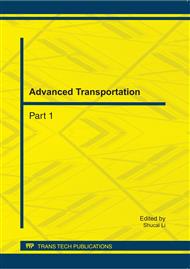p.550
p.554
p.560
p.566
p.570
p.576
p.583
p.587
p.591
Preferred Mode Choice Model for Commuter Purpose Based on Multinominal Logit Model
Abstract:
As a quasi-public traffic mode, more and more attention has been paid to the commuter bus to ease the traffic congestion. To get the travel behaviors of the commuters to which the commuter bus is available, The RP and SP survey about the travel behavior of commuters were carried out and the influencing factors of mode choice are discussed. The commuting mode combinations were found to exist during the decision-making process and there exist the preferred mode and secondary mode for each individual for one trip mode choice. The preferred mode choice model is established based on the multinomial logit mode. The results show that gender, month income, vehicle ownership, commuter cost, and commuter time have marked influences on the result of preferred mode choice for commuter purpose. The goodness of fit parameter ρ2 and goodness-of fit index adjusted by freedom ρ2 of the preferred mode choice model are 0.407 and 0.369 respectively, which implies that the forecast accuracy of the model is high. The VOT of the respondents in the survey is 29.9RMB/h and the results can provide a good reference for designing and optimizing of the commuter bus.
Info:
Periodical:
Pages:
570-575
Citation:
Online since:
September 2011
Authors:
Price:
Сopyright:
© 2011 Trans Tech Publications Ltd. All Rights Reserved
Share:
Citation:


